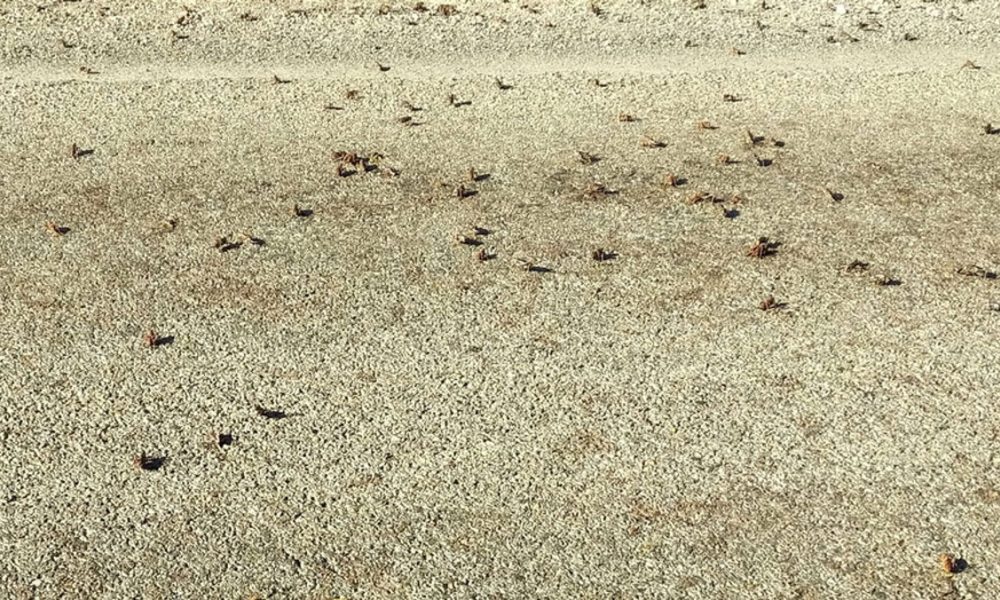
Mormon crickets are small but make a big impact as the Jordan Valley area found out recently when the tiny insects rolled over the area. (The Enterprise/Rosanne Zueger)
JORDAN VALLEY – Mormon crickets may chirp, but sometimes they crunch too.
Drivers on U.S. 95 in the Jordan Valley area in recent weeks have run over so many during the current outbreak that state highway workers had to bring out sweepers to clear the road.
And then they laid down chip seal – an oil-and-gravel mix – to help motorists keep traction.
The wave of Mormon crickets migrated into the Jordan Valley area of Malheur County two weeks ago but now seems to be diminishing.
This year U.S. Department of Agriculture reported that the risk of large outbreaks of crickets in eastern Oregon was the highest in the country.
Crickets flooded the area between the Idaho border and Jordan Valley, infesting crops and preventing farmers from baling hay.
“I’ve got hay that I should have baled about five days ago, but I can’t bale it because they’re all over,” said Dennis Stanford, who ranches in Jordan Valley.
Stanford said his cattle won’t eat hay full of the finger-sized insects because it’s harder to digest. He spotted the first wave of the crickets coming from the northeast near the Idaho border. Since then, the crickets have primarily stayed in the range and farmlands outside downtown Jordan Valley.
“They’ve become a real problem,” Stanford said.
The crickets aren’t eating his crops “but they’re obviously eating something in the area because they’ve gotten bigger since they first came,” Stanford said. He said they’ve been sustained by eating plants in local gardens. Although his crops haven’t been eaten, Stanford is worried the crickets will continue to prevent him from baling hay in the days to come.
As bands of several thousand crickets moved through the area, they got crushed under drivers’ tires because they can’t fly. The dark brown crickets crawl and hop across the ground. That made the roadway slick, according to Peter Murphy of the Oregon Department of Transportation.
Murphy said that no accidents were reported because of the crickets. Still, the agency deployed variable message signs on U.S. 95 to warn drivers of the hazard.
“Slow down, don’t freak out,” Murphy advised drivers. “It’s a natural phenomenon.”
There is no way to forecast how long the crickets will stay in one area. They can eat any vegetation they encounter, according to Stuart Reitz of the Malheur County Extension Service.
Reitz said the crickets, which are native to Western states, grow to be 3 inches long and are not actually crickets. They’re a type of katydid in the same family as crickets and grasshoppers.
The crickets lay their eggs in the summer, which hatch the following spring. Mild winters and wet springs can produce large outbreaks of the crickets. Those outbreaks can carry over into the next year if favorable conditions persist, according to Reitz.
Reitz said that when Mormon settlers moved out West they experienced outbreaks that could persist for up to 20 years.
Paul Blom, an entomologist with the Oregon Department of Agriculture, has been monitoring the Mormon cricket populations in the state for years. He said outbreaks like the one in Jordan Valley are common throughout eastern Oregon. Last year in Arlington, an outbreak moved into downtown, with crickets getting into homes. They made life miserable for a couple weeks, according to Blom.
He said there are a few ways people can manage such outbreaks. Since the crickets don’t fly, Blom said the environmentally-friendly option is to set up a physical barrier a few inches high on the ground. Slick surfaces such as aluminum flashing, available at hardware stores, work the best, according to Blom.
The crickets are cannibalistic. They may eat each other if they reach a barrier and can’t advance to fresh vegetation.
People can also spray insecticides according to federal guidelines.
“It’s better to get them while they’re young,” Blom said. The older they are, the thicker exoskeleton they’ll have, which may require higher amounts of insecticide.
“The point is never eradication, because they are a native species,” Blom said. The crickets are prey for animals like birds, badgers and coyotes.
Farmers with persistent problems that take a financial toll can also request cricket suppression assistance from the federal Animal and Plant Health Inspection Service. No one from the Jordan Valley area has done so yet, according to Blom.
Max Egener: [email protected] or 541-473-3377.




